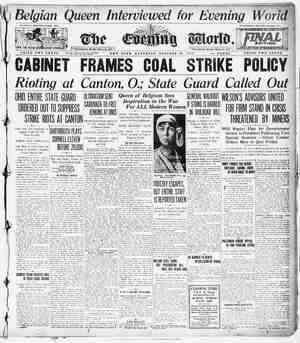The Seattle Star Newspaper, October 25, 1919, Page 11
You have reached the hourly page view limit. Unlock higher limit to our entire archive!
Subscribers enjoy higher page view limit, downloads, and exclusive features.
_ THe 8! ATILE STAR SATURDAY, OCTORER 2h t THE IMPENDING STRIKE OF THE COAL MINERS We believe it not only due our industry, but bat it is our duty to the public that the facts begarding the impending strike of coal miners |, be placed before the people in an accurate and \ straightforward manner. | For ten years the coal mines of this state have ted, for the most part harmoniously and @ith never a serivus interruptica, under formal Jagreement with the United Mine Workers of / Ameriza, an organization which covers most of ithe coal fields of the United States. 4 We mow have no local differences with our al officials on nationwide strike on Nove. Ist to enforce demands which include a flat ner cent increase in wages and a reduction rom the present eight hours to six hours per dq rE tet oars ots ders to Stvo dare per week, and that no mine work more than one ift per day. The six-hour per day demand is on @.“bank to bank” basis, which really means little more than five hours in the working The miners of this State now receive: * cally all coal is dug by what are known ntract Miners, who make up the larger of the underground force. They are paid way the ton or on an equivalent basis. CONTRACT MEN ARE NOW MAKING The national crisis that the demands of the miners has practically every individual in the land. A public cannot be asked to pay double the price FROM $5.89 to often as high as $16.00 and $18.00 for 8 hours. Average of contract men at present contract rates and throughout the whole State is, conservatively, more than $7.75 and in some of the principal mines regularly averages from $8.50 to over $9.00. The more skilled of the con- tract men seldom fall below $10.00, * # & * &* & * & 60 per cent increase is demanded above these rates and in addition a decrease in day men’s hours to six hours and contract men to the equivalent of little better than five. The pres- ent scale paid miners in this State is one of the highest, if not, as we believe, actually the high- est on the American continent. In this State the contract between miner and employer includes a fixed charge for rent, coal, water, and, in many cases, lights. With few ex- ceptions, if any, and those unimportant, there has been no increase in any of .these charges since years before the war. Rents for four and five-room dwelling houses run from $6.00 to $12.00 a month; coal is from $2.25 to $4.00 per ton. The overhead expense of coal mining is ab- normally high in this State, particularly in the Western part, and does not decrease as produc- tion goes down. Due to difficult natural condi- tions we must employ much more than the ay- erage of nonproducing men, many of them in positions which must be filled every hour of evéry day whether coal is being produced or not. , ventilation, maintenance, . tion and are at most of the mines a continuous necessity. Some of the principal mines are so deep and the overhead expense is so heavy that a two-shift daily production of coal is absolutely necessary to permit them to operate. The physical conditions in these mines are such that but little increase in per hour pro- duction can be realized through the addition of ple must bring about an equitable adjustment of this ‘serious situation. | Washington Coal Operators Associat 608 Lyon Building, Seattle, Wash. ' men or equipment. In that respect the same is true of most of the mines which work single Therefore, for the most part, every hour lost through decreased hours per day or days *- * & * © *% If the underground men work six hours “ to bank” the hoisting and haulage pi: will in nearly all of the mines be able to ca coal but little if any more than five hours a ¢ Therefore, if the miners’ demands were grante mines from 48 to 25 hours per week, a reduct of 74 and 48 per cent, . The kne deposits of the better coals are limited an there is no chance that more than a small p of this loss. would be made up through r mines being opened. There is little doubt but that the State wo fall from well over four million tolessthan t million tons a year production, from this ch in hours alone, : * * * &* * ~ Cost of production would be directly affect not only by the 60 per cent wage advance bul proportionally by the decrease in hours of we and tons of production and THE COST © COAL AT THE MINE WOULD BE INCREAS. ED BY FROM $3 TO $6 PER TON. THIS WOULD, OF NECESSITY, HAVE TO ADDED TO THE SELLING PRICE, The mining industry is one of the largest in © the State. It gives employment to over 6,000 men and annually spends upwards of $15,000, 000.00 in the State in payrolls, taxes and the purchase of supplies. itated vitally affects every line of industry ie cireccy overburdened by the high cost of necessities for its fuel. The sense of justice and fair play of the American peo- } \ f






